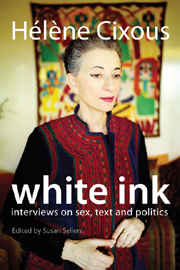Book contents
- Frontmatter
- Contents
- Acknowledgements
- Editor's note
- Preface: On being interviewed
- Part I Writing the enigma
- Part II Writing the feminine
- 5 When I do not write, it is as if I had died
- 6 My text is written in white and black, in “milk and night”
- Part III Writing and politics
- Part IV Writing and theatre
- Part V Writing roots
- Part VI On painting, music and nature
- Part VII Dialogues
- Envoi: But the Earth still turns, and not as badly as all that
- Bibliography of Hélène Cixous's works
- Index
6 - My text is written in white and black, in “milk and night”
from Part II - Writing the feminine
- Frontmatter
- Contents
- Acknowledgements
- Editor's note
- Preface: On being interviewed
- Part I Writing the enigma
- Part II Writing the feminine
- 5 When I do not write, it is as if I had died
- 6 My text is written in white and black, in “milk and night”
- Part III Writing and politics
- Part IV Writing and theatre
- Part V Writing roots
- Part VI On painting, music and nature
- Part VII Dialogues
- Envoi: But the Earth still turns, and not as badly as all that
- Bibliography of Hélène Cixous's works
- Index
Summary
This interview first appeared in Substance 13, 19–37, 1976.
cm I would like to talk about your two principal roles: scholar-essayist and “writer in the feminine” [“écrivaine”]. Concerning this word, I saw the defenses go up when I proposed to use it instead of “Women Writers” [“femmes écrivains”] at the convention of the International Association of Women Writers in Nice. Do you consider a certain renovation of language to be useful or pointless?
cixous You know, I don't even wonder about such things. I think that in France the language is very rigid. You, in the United States and I, too, in France share this experience: we are well aware that one knows how to fabricate neologisms; when there is a need for them, they come! As for their codification … usage decides. Personally, I don't know whether I would like the word “écrivaine” at the phonic level. Because of my mania for playing on the signifier, I hear with marked insistence the “vaine”, vaine in the sense of “empty”. Therefore I have this immediate reticence: I am not sure it is a good word, a beautiful word. But it is obviously quite a problem: I am convinced there is a great deal of work to be done on the lexicon.
cm Would you explain how you happened to found a group for women's studies?
cixous It has to do with a series of steps I have taken over the last few years.
- Type
- Chapter
- Information
- White InkInterviews on Sex, Text and Politics, pp. 58 - 78Publisher: Acumen PublishingPrint publication year: 2008

